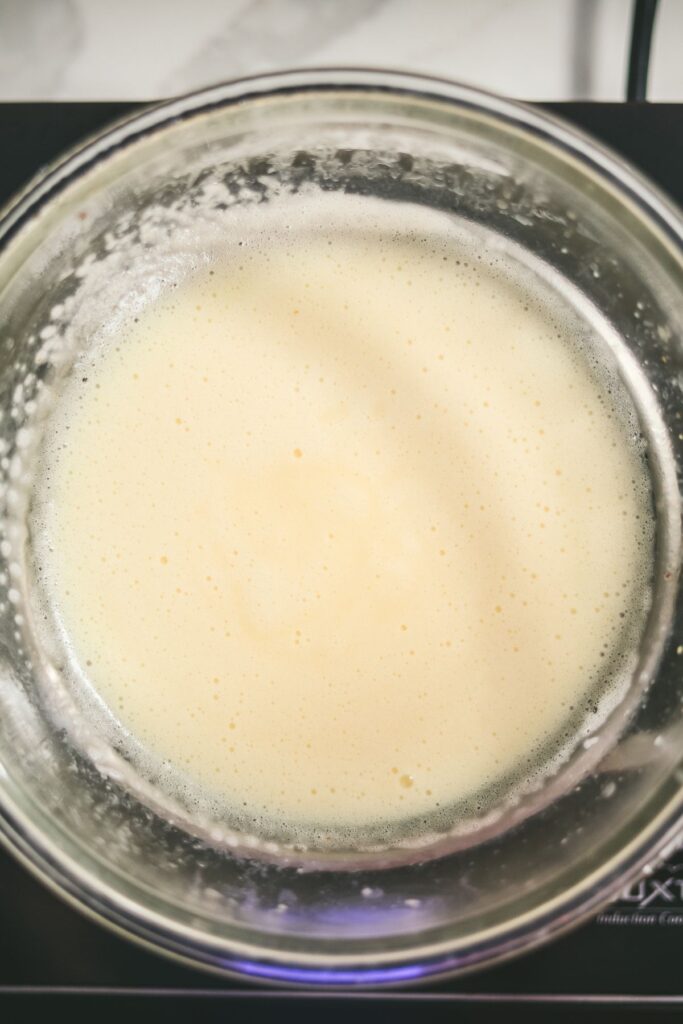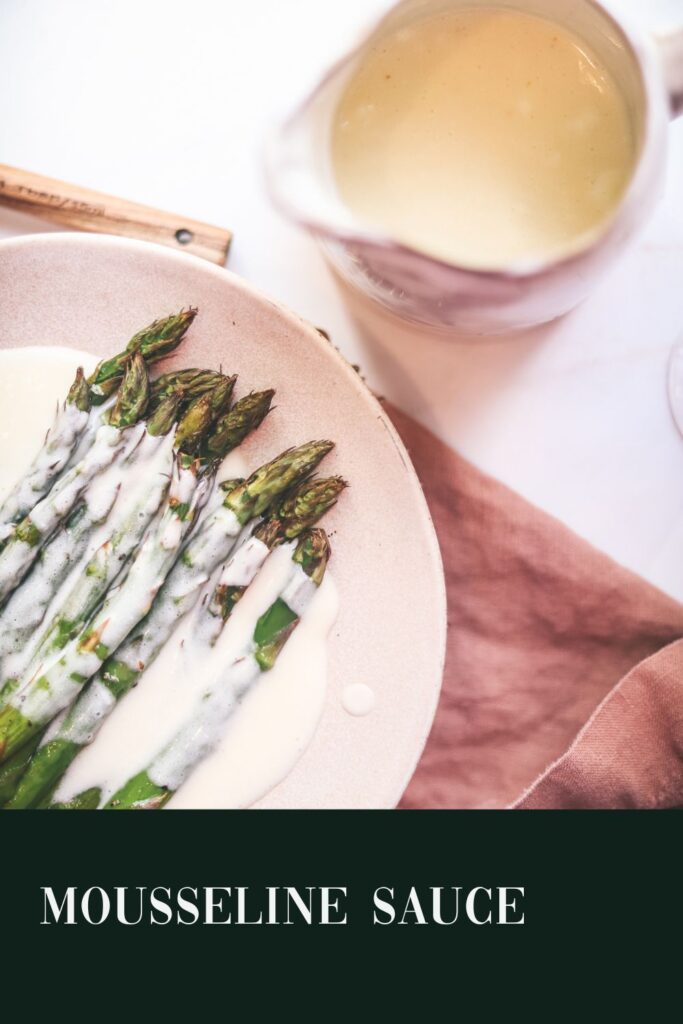As an Amazon Associate I earn from qualifying purchases.
If you've never had mousseline sauce, be prepared for your newest obsession. It's basically hollandaise sauce, but lighter and fluffier, because we're adding whipped cream to it. And no, before you ask, you shouldn't want to know the calorie count.

This classic French sauce is perfect for seafood an roasted vegetables, but really, it can top just about anything you can imagine or be used as a base for other sauces.
Mousseline sauce is amazing because it adds a rich, creamy flavor to any dish! Plus, the addition of whipped cream makes it lighter and fluffier than traditional hollandaise sauce, which makes it a great choice for any occasion.
Jump to:
Why You're Going to Love this Recipe
- The creaminess elevates any dish with its rich and indulgent flavor.
- Its light and fluffy texture sets it apart from other heavy sauces, making it a perfect choice for summer meals.
- Its versatility as a base for other sauces or a topping for desserts adds a new dimension to your culinary creations.
- It pairs beautifully with seafood and vegetables, enhancing their natural flavors.
- The smooth, silky texture creates an elegant presentation for any dish.
- The hint of lemon from the hollandaise base gives a bright, fresh touch to the sauce.

What is Mousseline Sauce?
Mousseline sauce is a variation of the classic hollandaise sauce, which is an emulsion of egg yolks, lemon juice, and butter. To make mousseline sauce, hollandaise is whipped with heavy cream to create a lighter and fluffier texture.
It has a creamy, rich flavor and is often used as a sauce for seafood dishes like poached salmon or asparagus. It can also be used as a base for other sauces or as a topping for desserts.
Where's it From?
Mousseline sauce is believed to have originated in 19th-century France. It's named after the French word "mousse," meaning foam or froth, which refers to the light and airy texture of the sauce. It was initially made by whipping hollandaise sauce with air to create a lighter and fluffier texture.
Over time, the recipe evolved to include heavy cream as a stabilizing ingredient, which helped to create the creamy and luxurious texture that we know and love today. Despite its evolution, mousseline sauce remains a classic French sauce that continues to be a favorite among chefs and home cooks.

Is it Hard to Make?
Mousseline sauce can be a bit finicky, but with a little patience and practice, you'll get the hang of it! The key to success is taking your time when making the hollandaise base and carefully emulsifying the egg yolks and butter. Once the hollandaise sauce is made, adding in the whipped cream is easy peasy. Just be careful not to over-whip the cream, or the sauce will become too thick. But with a little love and care, you'll be whipping up a delicious batch of mousseline sauce in no time!
Ingredients
Let's break down the ingredients in mousseline sauce and see why they work so well together.
- Egg yolks: They provide the base for the sauce and create a creamy, velvety texture.
- Lemon juice: It adds a tangy, bright flavor that balances the richness of the egg yolks and butter.
- Butter: It enriches the sauce and helps to create that gorgeous texture.
- Salt and cayenne pepper: They add seasoning and a touch of heat to the sauce.
- Heavy cream: It lightens and fluffs up the sauce, giving it a beautiful, mousse-like feel.
Combining these ingredients creates a delicious and versatile sauce that can be used in lots of different dishes. The egg yolks and butter provide richness, while the lemon juice and spices add brightness and flavor. The whipped cream adds lightness and airiness, making it the perfect finishing touch to any dish. It's a classic sauce that never fails to impress!

How to Make Mousseline Sauce
Ok, the ingredient list may be simple, but the technique, less so. Let's get into it! I promise you can do it!
First off, let's get the whipped cream out of the way. I have an immersion blender with a whisk attachment, so I just used that. You can use a hand mixer, a stand mixer, or just a whisk. Whatever works for you - just whip it to stiff peaks and then set it aside.

Get about 2 inches of water going in a medium-sized saucepan, small enough to hold a glass bowl on top that you're going to make the sauce in. You want the water to be a strong simmer, not a rolling boil - like this:

Whisk together the egg yolks, lemon juice, salt, and cayenne pepper in a medium glass bowl.

Set the bowl on top of your simmmering water.

Gradually add the melted butter to the egg yolk mixture, a little at a time, while continuously whisking. This process is called emulsification and it will help to create a smooth and creamy sauce.

Keep whisking the sauce until it thickens and coats the back of a spoon. Keep a very close eye on the temperature of your simmering water. If it gets too hot the eggs will scramble, and there's basically no coming back from that. Better to go low and slow and have patience! (Trust me, I've effed up hollandaise sauce enough times).

Remove the bowl from the heat and let it cool slightly.
Gently fold the whipped cream into the hollandaise sauce, making sure not to deflate the cream.

Serve immediately or keep the sauce warm in a heatproof bowl set over a pot of simmering water until ready to use.
Tips & Tricks
Keep it warm: Make sure to keep the sauce warm over a pot of simmering water until ready to use. If it gets too cold, it may become thick and difficult to incorporate.
Whisk continuously: Whisking the sauce constantly while it's over heat helps to prevent the eggs from scrambling and ensures a smooth and creamy texture.
Be patient with the butter: Gradually add the melted butter to the egg yolk mixture a little at a time, while whisking continuously. This helps to create a smooth and stable emulsion.
Keep it cool: Make sure to let the sauce cool slightly before folding in the whipped cream. If the sauce is too hot, it will melt the cream and ruin the mousse-like texture.
Fold, don't stir: When incorporating the whipped cream, use a gentle folding motion rather than a stirring motion. This will help to maintain the airy, mousse-like texture of the sauce.
Sorry, I couldn't resist. 😂😂😂
Adjust the seasoning: Taste the sauce and adjust the seasoning with additional salt, cayenne pepper, or lemon juice as needed.
Storage and Reheating
Store: If you have any leftover mousseline sauce, you can store it in an airtight container in the refrigerator for up to 2 days.
Reheat: To reheat the sauce, place it in a heatproof bowl over a pot of simmering water. Whisk the sauce continuously as it warms up to prevent it from separating. Alternatively, you can microwave the sauce in short intervals, whisking between each interval, until heated through.
It's important to remember that mousseline sauce is a delicate emulsion and may separate if not heated or stored properly. By following these tips, you'll be able to enjoy your delicious mousseline sauce anytime you want!

What to Serve it With
- Fish: Mousseline sauce is a classic accompaniment to fish dishes, especially salmon or halibut.
- Vegetables: For a delicious side dish, try serving it with steamed vegetables, such as asparagus or green beans.
- Eggs: Mousseline sauce is a great topping for eggs dishes, like scrambled eggs or omelets.
- Pasta: Pair mousseline sauce with pasta dishes, such as fettuccine alfredo or spaghetti carbonara, for a creamy and rich sauce.
- Meat: Mousseline sauce can also be used as a sauce for meats, such as chicken, pork chops, or even meatloaf.
Other Great Sauces
📖 Recipe

Mousseline Sauce
Equipment
- Hand mixer or stand mixer for making whipped cream (you can also whisk by hand)
Ingredients
- ½ C heavy cream whipped to stiff peaks
- 3 egg yolks
- 2 tablespoon lemon juice
- ½ C butter melted
- ⅛ teaspoon salt
- ⅛-¼ teaspoon cayenne pepper
Instructions
- In a medium glass bowl, whip the heavy cream to stiff peaks. Be careful not to over-whip the cream or it will become too thick. Set aside.
- Fill a medium sauce pan with about 2 inches of water. Set over medium heat and bring to a simmer (see photos above or video to check out what this looks like - it shouldn't be a hard boil).
- Whisk together the egg yolks, lemon juice, salt, and cayenne pepper in a medium glass bowl.
- Place the glass bowl over the saucepan with the simmering water. Whisk constantly. If you see your eggs start to clump at any point - remove from the heat IMMEDIATELY, and keep whisking. Then turn your heat down and keep going (but, the sauce might be bust at this point. The eggs CANNOT scramble).
- Slowly add the butter in a drizzle, whisking as you go.
- Once all the butter is added, continue whisking the sauce until it thickens, enough to coat the back of a spoon.
- Take the bowl off the heat, and let it cool for 5 minutes.
- Fold in the whipped cream gently, we don't want to lose that fluffy and airy texture.
- Once the sauce is smooth, taste for seasoning, and adjust as necessary. Serve immediatly.
Video
Notes
Nutrition
Hi, I'm Cara! I'm a food writer, journalist, and recipe developer. I'm obsessed good food, good wine, good cocktails and entertaining. I've picked up a few tips over the years, and love sharing them with others.











Leave a Reply